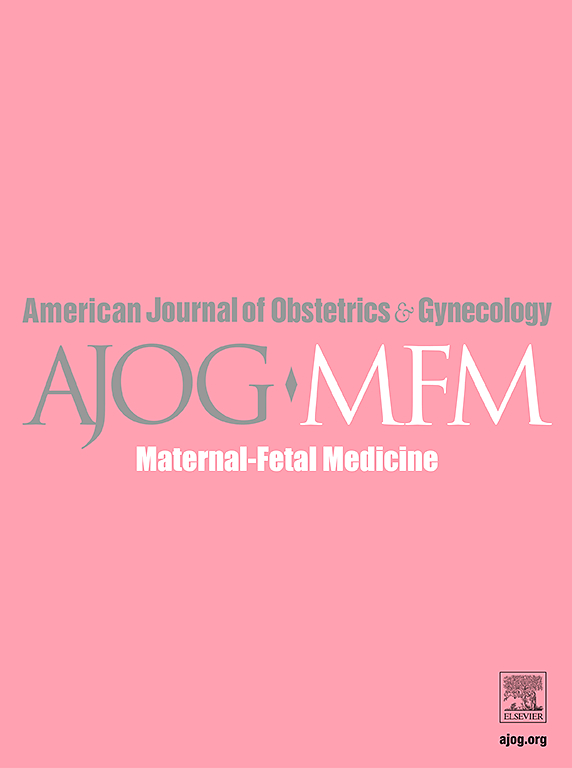在实践咨询认可其考虑后,22周妊娠出生的婴儿的产前皮质类固醇管理。
IF 3.1
2区 医学
Q1 OBSTETRICS & GYNECOLOGY
American Journal of Obstetrics & Gynecology Mfm
Pub Date : 2025-06-22
DOI:10.1016/j.ajogmf.2025.101728
引用次数: 0
摘要
背景:为了回应越来越多的证据支持在妊娠22周时给予类固醇并计划进行新生儿复苏,美国妇产科学院(ACOG)与母胎医学会一起,于2021年9月发表了一项临床实践建议,建议在妊娠22周时考虑使用类固醇。目的:确定2021年ACOG实践咨询是否与妊娠22周出生的婴儿使用产前皮质类固醇的增加有关。研究设计:我们的回顾性、二次分析使用了2017-2023年美国疾病控制和预防中心国家生命统计系统的数据。主要结局是出生证明上记录的产前类固醇使用情况,我们的主要暴露是出生年份,将其分为实践指南实施后(2022-2023)和之前(2017-2020)。分别使用卡方检验和秩和检验来比较指南实施前后的胎龄。采用差异规格差异模型的多变量回归来确定22周和24-25周出生的产前类固醇使用情况,并采用23周活产的单独多变量模型作为敏感性分析。结果:应用我们的排除标准后,2017-2020年至2022-2023年期间,美国22-25周妊娠的11,203例活产婴儿可用于分析。我们的双变量分析表明,在实施ACOG指南后,22周妊娠活产婴儿的产前类固醇使用率从之前的48%(178/368)增加到61% (216/356)(p = 0.001)。然而,在我们的双变量分析中,类固醇给药在23周时没有改变(p = 0.385),仅在24-25周时从63%轻微增加到66% (p = 0.033)。我们的多变量分析发现了类似的模式,22周出生时使用类固醇的几率高出65% (p = 0.001),而24-25周出生时没有显著变化(p = 0.061)。在我们的敏感性分析中,在22周出生时发现了类似的结果(p = 0.001),但在23周出生时没有发现显著的关联(p = 0.710)。结论:ACOG建议在妊娠22周的早产儿中考虑使用皮质类固醇,这导致了这种临床实践的增加。这一重要的关联突出了临床医生的临床实践指南的价值和影响。本文章由计算机程序翻译,如有差异,请以英文原文为准。
Antenatal corticosteroid administration among infants born at 22 weeks’ gestation after a practice advisory endorsing its consideration
BACKGROUND
In response to an accumulation of evidence supporting antenatal steroid administration at 22 weeks of gestation with planned neonatal resuscitation, the American College of Obstetricians and Gynecologists, alongside the Society for Maternal-Fetal Medicine, published a clinical practice advisory recommending consideration of antenatal steroids at 22 weeks of gestation in September 2021.
OBJECTIVE
This study aimed to determine whether the 2021 American College of Obstetricians and Gynecologists practice advisory was associated with an increase in the use of antenatal corticosteroids among infants born at 22 weeks of gestation.
STUDY DESIGN
This retrospective, secondary analysis used data from the United States Centers for Disease Control and Prevention’s National Vital Statistics System from 2017 to 2023. The primary outcome was antenatal steroid use as recorded on the birth certificate, and our main exposure was the birth year that was dichotomized as after (2022–2023) vs before (2017–2020) practice guideline implementation. The chi-square and rank-sum tests were used to compare gestational age before and after the implementation of the guideline, respectively. A multivariate regression using a difference-in-difference specification model was used to determine antenatal steroid use among births at 22 and 24 to 25 weeks of gestation, and a separate multivariate model was included using live births at 23 weeks of gestation for sensitivity analysis.
RESULTS
After applying our exclusion criteria, a total of 11,203 live births in the United States at 22 to 25 weeks of gestation between 2017–2020 and 2022–2023 were available for analysis. Our bivariate analysis indicated an increased use of antenatal steroids in live births at 22 weeks of gestation from 48% (178/368) before to 61% (216/356) after the American College of Obstetricians and Gynecologists guideline implementation (P=.001). However, steroid administration did not change at 23 weeks of gestation (P=.385), with only a slight increase from 63% to 66% at 24 to 25 weeks of gestation (P=.033) in our bivariate analysis. Our multivariate analysis found similar patterns, with 65% higher odds of steroid use in births at 22 weeks of gestation (P=.001), with no significant change in births at 24 to 25 weeks of gestation (P=.061). Similar results were found in our sensitivity analysis of births at 22 weeks of gestation (P=.001), but no significant association was identified for births at 23 weeks of gestation (P=.710).
CONCLUSION
The recommendation by the American College of Obstetricians and Gynecologists to consider antenatal corticosteroid administration in preterm deliveries at 22 weeks of gestation has led to an increase in this clinical practice. This significant association highlights the value and influence of clinical practice guidelines among clinicians.
求助全文
通过发布文献求助,成功后即可免费获取论文全文。
去求助
来源期刊

American Journal of Obstetrics & Gynecology Mfm
Medicine-Medicine (all)
CiteScore
7.40
自引率
3.20%
发文量
254
审稿时长
40 days
期刊介绍:
The American Journal of Obstetrics and Gynecology (AJOG) is a highly esteemed publication with two companion titles. One of these is the American Journal of Obstetrics and Gynecology Maternal-Fetal Medicine (AJOG MFM), which is dedicated to the latest research in the field of maternal-fetal medicine, specifically concerning high-risk pregnancies. The journal encompasses a wide range of topics, including:
Maternal Complications: It addresses significant studies that have the potential to change clinical practice regarding complications faced by pregnant women.
Fetal Complications: The journal covers prenatal diagnosis, ultrasound, and genetic issues related to the fetus, providing insights into the management and care of fetal health.
Prenatal Care: It discusses the best practices in prenatal care to ensure the health and well-being of both the mother and the unborn child.
Intrapartum Care: It provides guidance on the care provided during the childbirth process, which is critical for the safety of both mother and baby.
Postpartum Issues: The journal also tackles issues that arise after childbirth, focusing on the postpartum period and its implications for maternal health. AJOG MFM serves as a reliable forum for peer-reviewed research, with a preference for randomized trials and meta-analyses. The goal is to equip researchers and clinicians with the most current information and evidence-based strategies to effectively manage high-risk pregnancies and to provide the best possible care for mothers and their unborn children.
 求助内容:
求助内容: 应助结果提醒方式:
应助结果提醒方式:


